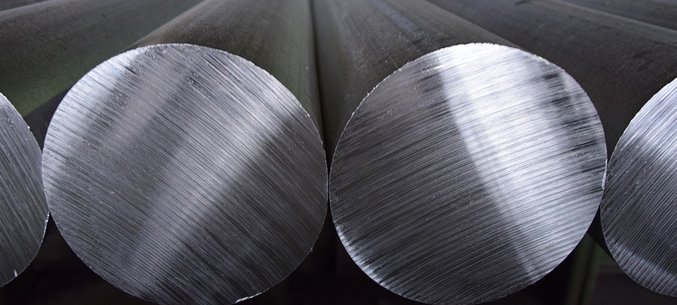
Unwrought aluminum exports by country totaled US$55.9 billion in 2017, up by 22% for all aluminum-shipping nations over the five-year period starting in 2013. Year over year, the value of exported aluminum appreciated 26.1% from 2016 to 2017.
Spelled aluminium by British writers, aluminum is the world’s most widely used non-iron and non-steel metal and is the basic ingredient for a wide range of recyclable products. The latter includes beverage cans, construction materials and transport vehicles. Silvery-white in color, pure aluminum is non-magnetic and is also notable for its low density, relatively light weight and resistance to corrosion.
Among continents, European countries accounted for the highest dollar worth of exported aluminum during 2017 with shipments valued at $23.9 billion or 42.7% of the global total. In second place were Asian exporters at 31.7% while 13.5% of worldwide aluminum shipments originated from North America. Smaller percentages came from Oceania led by Australia and dramatically trailed by New Zealand (5.8%), Africa (3.9%) then Latin America excluding Mexico but plus the Caribbean (2.4%).
The 4-digit Harmonized Tariff System code prefix for raw aluminum is 7601.
Countries
Below are the 15 countries that exported the highest dollar value worth of aluminum during 2017:
- Canada: US$6.3 billion (11.3% of total exported aluminum)
- United Arab Emirates: $5.63 billion (10.1%)
- Netherlands: $5.62 billion (10.1%)
- Russia: $5.5 billion (9.8%)
- Norway: $3.1 billion (5.5%)
- Australia: $2.6 billion (4.7%)
- India: $2.4 billion (4.3%)
- Malaysia: $2.1 billion (3.7%)
- Iceland: $1.6 billion (2.9%)
- Bahrain: $1.31 billion (2.3%)
- Qatar: $1.29 billion (2.3%)
- Saudi Arabia: $1.21 billion (2.2%)
- United States: $1.16 billion (2.1%)
- Germany: $1.09 billion (2%)
- China: $1.06 billion (1.9%)
The listed 15 countries shipped about three-quarters (75.1%) of global aluminum exports in 2017 by value.
Among the above countries, the fastest-growing aluminum exporters since 2013 were: Bahrain (up 474.1%), United Arab Emirates (up 262.5%), Saudi Arabia (up 240.7%) and India (up 157.2%).
Five countries posted declines in their international aluminum sales namely Australia (down -23.9%), China (down -16.8%), Russia (down -10.9%), United States (down -7.8%) and Iceland (down -1.9%).
Advantages
The following countries posted the highest positive net exports for aluminum during 2017. Investopedia defines net exports as the value of a country’s total exports minus the value of its total imports. Thus, the statistics below present the surplus between the value of each country’s exported aluminum and its import purchases for that same commodity.
- Canada: US$6 billion (net export surplus up 13.2% since 2013)
- United Arab Emirates: $5.6 billion (up 267.5%)
- Russia: $5.4 billion (down -8.2%)
- Australia: $2.5 billion (down -24.6%)
- Norway: $2.5 billion (up 6.0%)
- India: $1.8 billion (up 911.5%)
- Iceland: $1.6 billion (down -3.7%)
- Qatar: $1.3 billion (reversing a -$9 million deficit)
- Bahrain: $1.2 billion (up 515.3%)
- Malaysia: $1.1 billion (up 297.1%)
- Saudi Arabia: $1 billion (up 250.7%)
- South Africa: $926.6 million (down -12.2%)
- China: $667.6 million (up 147.3%)
- Argentina: $660.8 million (up 23.8%)
- New Zealand: $640.3 million (up 2.3%)
Canada has the highest surplus in the international trade of aluminum. In turn, this positive cashflow confirms the strong Canadian global competitive advantage for this specific product category.
Opportunities
The following countries posted the highest negative net exports for aluminum during 2017. Investopedia defines net exports as the value of a country’s total exports minus the value of its total imports. Thus, the statistics below present the deficit between the value of each country’s imported aluminum purchases and its exports for that same commodity.
- United States: -US$9.8 billion (net export deficit up 87.5% since 2013)
- Japan: -$5.6 billion (up 7.6%)
- Germany: -$4.6 billion (down -5.9%)
- South Korea: -$3.1 billion (up 5.4%)
- Turkey: -$2.2 billion (up 2.8%)
- Italy: -$1.9 billion (up 41.2%)
- Mexico: -$1.8 billion (up 30.4%)
- Thailand: -$1.4 billion (up 22.8%)
- Taiwan: -$1 billion (up 1%)
- Poland: -$944.4 million (up 71.8%)
- Vietnam: -$656.9 million (up 52.6%)
- Austria: -$587.2 million (up 78.9%)
- Hungary: -$585.1 million (down -9.9%)
- Indonesia: -$575.3 million (down -0.4%)
- France: -$573.6 million (down -16.5%)
United States incurred the highest deficit in the international trade of aluminum in 2017. America’s negative trade balance for aluminum continues to grow by double-digits. The aluminum-specific deficit for the US expanded to -$9.8 billion during 2017 up by 87.5% from its -$5.2 billion in red ink in 2013 and up by 31.8% from -$7.4 billion for 2016.
These negative cashflows highlight America’s competitive disadvantage for this specific product category and conversely signals opportunities for aluminum-supplying countries that help satisfy the powerful demand. Given that America imported a total $10.9 billion worth of unwrought aluminum, President Trump’s proposal to enforce a 10% tariff could rake in an annual $1.1 billion in international tax revenues for the United States.
Companies
Aluminum Exporting Companies
Below are global aluminum-processing conglomerates that represent established players engaged in the international trade of aluminum. The home country for each selected aluminum producer or rolling company is shown within parenthesis.
- Alcoa (United States)
- Alumina Limited (Australia)
- Chalco (China)
- Emirates Global Aluminium (United Arab Emirates)
- Hindalco Industries (India)
- Norsk Hydro ASA (Norway)
- United Company RUSAL (Russia)
Source: worldstopexports.com
